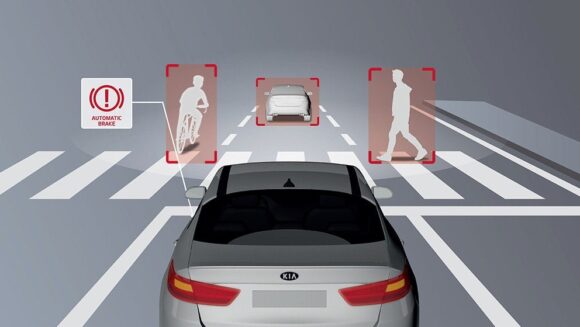Crash-avoidance technology appears to benefit young drivers more than older motorists, reducing claim rates by more than half for drivers under 25 when the vehicle is equipped with a wide array of devices, according to research by the Highway Loss Data Institute.
The research shows that drivers under 25 who used the Kia Drive Wise system had 57% fewer property damage liability claims when compared to drivers of the same age group who drove identical, unequipped vehicles. Drivers 25 to 64 saw 41% fewer property damage claims, while drivers over 65 had 31% fewer.
More modest claim rates reductions were documented for Subaru and Honda vehicles equipped with automated driver assistance systems (ADAS). Young drivers also experienced the most benefit.
“Earlier studies have also shown that younger drivers have higher claim frequencies as well as more front crashes than drivers of other ages,” the report says. “Both facts support the findings in this research that the younger drivers may benefit more from front crash prevention systems like Drive Wise.”
The research report released Wednesday summarizes findings from three studies that analyzed claim rates by drivers who drove:
- 2017-2019 Kia Sportages equipped with the Drive Wise package.
- All models of Subaru equipped with the EyeSight system.
- 2013 to 2015 Honda Accords equipped with forward collision warning, lane departure warning and passenger side blind spot monitoring.
Matt Moore, senior vice president of the institute, said those specific vehicles were chosen because the manufacturers identify the type of safety equipment within the vehicle identification number, making it easier to quickly gather data.
Honda drivers younger than 25 experienced a 17% reduction in property damage liability claims. Drivers 25 to 64 experienced an 11.5% reduction. Drivers 65 and older saw a 3% reduction.
Subaru drivers younger than 25 saw a 21% reduction in property claims. Drivers 25 to 65 experienced an 18.5 reduction. Drivers 65 and older saw a 6% reduction.
ADAS systems also decreased collision claims rates for drivers under 65. Kia again led the pack with a 27% reduction for drivers under 25, 12% for drivers 25 to 64 and 13% for drivers over 65.
Motorists under 25 who drove Hondas and Subarus saw 5% reductions in collision claims, witholder drivers seeing more modest reductions. Drivers older than 65 actually saw a small increase in collision claims for both Honda and Subaru (less than 2%), but the institute said the difference wasn’t statistically significant.
Moore said Kia’s Drive Wise system, available on the SX Turbo trim level, stands out because the package contains more devices, and some of those devices are more sophisticated. Drive Wise includes forward collision warning with automatic emergency braking, blind-spot monitoring, lane departure warning, curve-adaptive headlights, high-beam assistance, rear cross-traffic, reverse parking collision warning, rear parking assist, and surround view monitor.
The reverse parking warning alerts the driver if another vehicle is crossing behind while the driver is backing out of a parking lot. The Kia lane-departure warning applies the brakes automatically if a driver ignores the warning signal and tries to pull into the path of another vehicle.
“We’ve assessed big basket of technology in that Drive Wise analysis,” he said.
Technology doesn’t come cheap. The SX Turbo version of the Sportage costs about $9,000 more than the lowest trim level, according to truecar.com, but also includes more horsepower, leather seats and all-wheel drive.
Subaru’s EyeSight package includes forward collision warning with automatic emergency braking, adaptive cruise control with complete stop, lane departure warning, lead vehicle start alert, rear vehicle detection, blind spot detection, lane change assist and a rear cross traffic alert.
Honda Accords are equipped with forward collision warning, lane departure warning and blind spot monitoring.
Moore said the institute has not examined ADAS systems used by other manufacturers because of the difficulty in identifying vehicles that have the equipment, but he expects that similar technology will result in similar reductions in claim rates.
Photo illustration courtesy of Kia.
Was this article valuable?
Here are more articles you may enjoy.


 Bayer Gets Supreme Court Hearing in Challenge to Roundup Suits
Bayer Gets Supreme Court Hearing in Challenge to Roundup Suits  First Brands Judge Approves Examiner to Probe Fraud Allegations
First Brands Judge Approves Examiner to Probe Fraud Allegations  Munich Re: Insured Losses From Wildfires, Storms and Floods Hit Record High
Munich Re: Insured Losses From Wildfires, Storms and Floods Hit Record High  Storm Goretti Batters Europe With Violent Winds, Power Cuts
Storm Goretti Batters Europe With Violent Winds, Power Cuts 